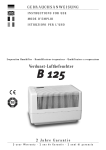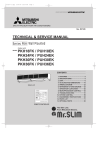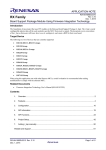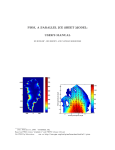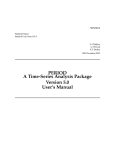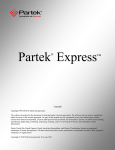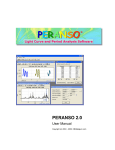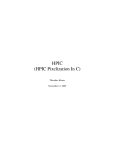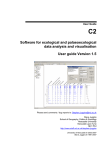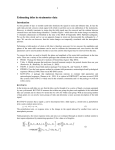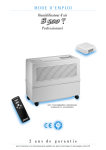Download Spectrum spectral analysis paleoclimatic time series
Transcript
PII: Computers & Geosciences Vol. 23, No. 9, pp. 929±945, 1997 # 1998 Elsevier Science Ltd. All rights reserved Printed in Great Britain 0098-3004/97 $17.00 + 0.00 S0098-3004(97)00087-3 SPECTRUM: SPECTRAL ANALYSIS OF UNEVENLY SPACED PALEOCLIMATIC TIME SERIES MICHAEL SCHULZ1 and KARL STATTEGGER2 UniversitaÈt Kiel, Sonderforschungsbereich 313, Heinrich-Hecht-Platz 10, D-24118 Kiel, Germany, and 2 UniversitaÈt Kiel, Geologisch-PalaÈontologisches Institut, Olshausenstr. 40, D-24118 Kiel, Germany (e-mail: [email protected]) 1 (Received 19 February 1997; revised 21 May 1997) AbstractÐA menu-driven PC program (SPECTRUM) is presented that allows the analysis of unevenly spaced time series in the frequency domain. Hence, paleoclimatic data sets, which are usually irregularly spaced in time, can be processed directly. The program is based on the Lomb±Scargle Fourier transform for unevenly spaced data in combination with the Welch-Overlapped-Segment-Averaging procedure. SPECTRUM can perform: (1) harmonic analysis (detection of periodic signal components), (2) spectral analysis of single time series, and (3) cross-spectral analysis (cross-amplitude-, coherency-, and phase-spectrum). Cross-spectral analysis does not require a common time axis of the two processed time series. (4) Analytical results are supplemented by statistical parameters that allow the evaluation of the results. During the analysis, the user is guided by a variety of messages. (5) Results are displayed graphically and can be saved as plain ASCII ®les. (6) Additional tools for visualizing time series data and sampling intervals, integrating spectra and measuring phase angles facilitate the analysis. Compared to the widely used Blackman±Tukey approach for spectral analysis of paleoclimatic data, the advantage of SPECTRUM is the avoidance of any interpolation of the time series. Generated time series are used to demonstrate that interpolation leads to an underestimation of high-frequency components, independent of the interpolation technique. # 1998 Elsevier Science Ltd. All rights reserved Key Words: Spectral analysis, Harmonic analysis, Cross-spectral analysis, Irregular sampling intervals, Interpolation, Lomb±Scargle Fourier transform. INTRODUCTION Spectral analysis is an important tool for deciphering information from paleoclimatic time series in the frequency domain. It is used to detect the presence of harmonic signal components in a time series or to obtain phase relations between harmonic signal components being present in two dierent time series (cross-spectral analysis). A widely used method for spectral analysis is the Blackman±Tukey method (BT; e.g. Jenkins and Watts, 1968). See Figure 1. It is based on the standard Fourier transform of a truncated and tapered (to suppress spectral leakage) autocovariance function. The major drawback of this approach is the requirement of evenly spaced time series tn1 ÿ tn const 8n. In general, paleoclimatic time series are unevenly spaced in time, thus requiring some kind of interpolation before BT spectral analysis can be performed. As will be outlined below, interpolation leads to an underestimation of high frequency components in a spectrum (`reddening' of a spectrum) independent of the employed interpolation scheme. Since cross-spectral analysis using the Blackman± Tukey method requires identical sampling times for both time series, that is t1 n t2 n8n, the compu929 tational eort (interpolation) is considerable if several time series with dierent average sampling intervals have to be analyzed. Furthermore, the interpolation of unevenly spaced time series may signi®cantly bias statistical results because the interpolated data points are no longer independent. A menu-driven PC program (SPECTRUM) has been developed in order to avoid these problems. SPECTRUM is based on the Lomb±Scargle Fourier transform (LSFT; Lomb, 1976; Scargle, 1982, 1989) for unevenly spaced time series in combination with a Welch-Overlapped-Segment-Averaging procedure (WOSA; Welch, 1967; cf. Percival and Walden, 1993, p. 289) for consistent spectral estimates (Fig. 1). Hence, unevenly spaced time series can be directly analyzed by SPECTRUM without preceding interpolation. The main features of SPECTRUM include: (1) autospectral analysis; (2) harmonic analysis (detection of periodic signal components); (3) crossspectral analysis (cross-amplitude-, coherency-, and phase-spectrum; cross-spectral analysis does not require a common time axis of the two processed time series); (4) analytical results are supplemented by statistical parameters that allow the evaluation of the results; (5) results are displayed graphically and can be saved as plain ASCII ®les; and (6) additional tools for visualizing time series data and sampling 930 M. Schulz and K. Stattegger Figure 1. Computational steps in univariate spectral analysis. Left column shows estimation of spectrum of SPECMAP oxygen isotope stack (top; Imbrie and others, 1984) by Welch-OverlappedSegment-Averaging (WOSA) method. Estimated spectrum results from averaging (in this example) three raw spectra. Right column shows steps performed in Blackman±Tukey (BT) method. Estimated autospectrum is Fourier transform of truncated autocovariance function (acvf). Master parameters that control results are number of segments in WOSA and truncation point of acvf (M) in BT. Unevenly spaced time series can be directly processed using WOSA method, but not by BT method. intervals, integrating spectra and measuring phase angles facilitate the analysis. The paper is organized as follows: the next three sections provide the mathematical background of the methods implemented in SPECTRUM. Subsequently, the eect of dierent interpolation schemes on spectral estimates is discussed, and ®nally, two examples will be given. A description of Spectral analysis of paleoclimatic time series 931 the installation and usage of SPECTRUM is provided in the Appendix. The paleoclimatic time series used in this paper re¯ect late Pleistocene climate variability as documented by marine sedimentary records. The generated time series have properties (length, sampling interval) similar to these data sets. SPECTRUM can, of course, be applied to data re¯ecting other time-scales, for example time series documenting Holocene climate variability. that Equation (1c) diers from the phase factor given by Scargle (1989; Eq. II.2 therein). It is, however, identical to the factor used in his algorithm. For univariate spectral analysis, tf is set to zero. Since tf allows a virtual shift of a time series along the time axis, it can be used to align two time series in cross-spectral analysis (see later). The least squares approach of the LSFT can be considered as follows. Let UNIVARIATE SPECTRAL ESTIMATION x fk tn ak sin o k tn bk cos o k tn Scargle (1982, 1989) developed a discrete Fourier transformation (DFT) that can be applied to evenly and unevenly spaced time series. Let x n x tn , n = 1, 2,..., N denotes a discrete, second-order stationary time series with zero mean. The DFT is then given by: X Ax n cos o k tn 0 Xk X o k F0 n iBx n sin o k tn 0 , 1a with o k 2pfk > 0, k 1, 2,:::, K, tn 0 tn ÿ t o k 1b p F0 o k 1= 2 exp fÿio k tf ÿ t o k g A o k B o k and X n X n cos2 o k tn 0 sin2 o k tn 0 2X t o k ÿ1=2 1c , ÿ1=2 sin 2o k tn 1d 3 1 7 6 n arctan 4X 5: 2o k cos 2o k tn 1e n The constant t ensures time invariance of the DFT, that is a constant shift of the sampling times (tn 4tn+T0), will not aect the result because such a shift will produce an identical shift in Equation (1e), that is t 4 t + T0 and therefore cancel in the arguments of Equations (1a) and (d) (Scargle, 1982). Furthermore, Scargle (1982) showed that this particular choice of t makes Equations (1a)±(1e) equivalent to the ®t of sineand cosine functions to the time series by means of least squares. The latter was already investigated by Lomb (1976) in conjunction with spectral analysis, and therefore, the method is referred to as Lomb± Scargle Fourier transform (LSFT). The response of a Fourier transformation to a time shift should be a phase shift of the Fourier components. The factor expfÿio k tf ÿ t o k g in Equation (1c) produces such a phase shift depending on the time tf. Note 2 be a discrete model for a signal component of x(tn) with frequency fk. The LSFT minimizes the sum of squares J(fk) of the dierences between the model from Equation (2) and the data: min! J fk N X n1 x tn ÿ x fk tn 2 , k 1, 2,:::, K: 3 An important aspect of the LSFT involves the choice of K, that is the number of frequencies used in Equation (2). Although there is no principal limit for K, it can be anticipated that a ®nite-length time series will only result in a ®nite amount of statistically independent Fourier components and, hence, frequencies in Equation (2). Using Monte-Carlo experiments, Horne and Baliunas (1986) showed that in the situation of an evenly spaced time series of length N, the number of independent frequencies in ÿ fNyq , fNyq is N fNyq 1= 2Dt denotes the Nyquist frequency according to the sampling theorem (e.g. Bendat and Piersol, 1986, p. 337)) and is thus identical to a standard Fourier transformation. The same holds true for unevenly spaced time series, where the samples are almost uniformly distributed along the time axis. The latter usually applies to paleoclimatic time series obtained from marine deep-sea sediments. A signi®cant clustering of samples along the time axis may decrease the number of statistically independent frequencies to 1/3 N (Horne and Baliunas, 1986). In practice, it is generally useful to choose K>N, since the resulting oversampling results in smoother spectral estimates (Scargle, 1982). This is equivalent to zero-padding in standard Fourier techniques. For unevenly spaced time series, the Nyquist frequency cannot be given, because the sampling theorem applies only to evenly spaced time series. In this situation, an average Nyquist frequency hfNyq i 1= 2hDti, with hDti being the average sampling interval, can be used as alternative. Sections of a time series where Dtn <hDti contain frequency information above hfNyq i. Choosing frequencies in Equation (2) above hfNyq i allows the investigation of this frequency region. Since it is almost impossible to assess the maximum frequency up to which an unevenly spaced time series contains signi®cant information, this option should be used 932 M. Schulz and K. Stattegger with great care. Selecting K such that fK hfNyq i results in a conservative choice of the frequency range. A plot of jXk j2 versus frequency results in a rawspectrum, which is an inconsistent estimator of the true spectrum (e.g. Bendat and Piersol, 1986, p. 285). Welch (1967) proposed an estimation procedure that results in consistent spectral estimates: a time series of length N is split into n50 segments of length Nseg that overlap each other by 50% (Welch-OverlappedSegment-Averaging, WOSA; Fig. 1), hence, Nseg=2N/(n50+1). In order to avoid spectral leakage, each segment is multiplied by a taper (e.g. Hanning-window; see Harris (1978) for an overview of the spectral windows used in SPECTRUM) in the time domain. The window weights wn are scaled such P 2 that wn NSeg . Subsequently, the n50 windowed segments are Fourier-transformed using Equations (1a)±(1e). Averaging the n50 raw-spectra yields a consistent estimate of an autospectrum (Bendat and Piersol, 1986, p. 392): G^ xx fk n50 X 2 jXi fk j2 , k 1, 2,:::, K: n50 Df NSeg i1 In order to assess the resolution of G^ xx fk along the frequency axis, the 6-dB bandwidth Bw is commonly utilized: Bw bw Df , where bw is the normalized bandwidth that depends on the spectral window being used (Harris, 1978). Details of G^ xx fk cannot be resolved within Bw. BIVARIATE SPECTRAL ESTIMATION Let x n x tx,n , with n = 1, 2,..., Nx and yn y ty,n , with n = 1, 2,..., Ny, denote two discrete, second-order stationary time series each with zero mean. In addition to the direct applicability to unevenly spaced time series, the LSFT after Equations (1a)±(1e) does not require that tx,n=ty,n8n in order to perform cross-spectral analysis (Scargle, 1989). Therefore, two time series with arbitrary spacing of the samples can be processed directly without prior interpolation. We adopt the following, conservative choices for the average sampling interval and the fundamental frequency: ÿ Dtxy max hDtx i, hDty i , 7 4 The scaling of G^ xx fk in Equation (4) is such that P ^ Df Gxx fk s^ 2x , with Df / 1= NSeg hDti being the fundamental frequency and s^ 2x as the estimated variance of a time series. Since the components of a raw spectrum are w2-distributed random variables with 2 degrees of freedom (Percival and Walden, 1993, p. 221), G^ xx fk also follows a w2 distribution. Each of the n50 spectra in Equation (4) increases the degrees of freedom, thus reducing the standard error of the spectral estimate. However, the 50% overlap of the n50 segments introduces a correlation between the segments and an eective number of segments ne results that is smaller than n50: ÿ1 2c2 neff n50 1 2c250 ÿ 50 , 5 n50 where c50 R0.5 is a constant that depends on the applied spectral window (Welch, 1967). Harris (1978) provides values for c50 for a variety of spectral windows that are adopted in SPECTRUM. Finally, (1 ÿ a) con®dence intervals for G^ xx fk can be calculated according to: ^ nGxx fk nG^ xx fk R G f R n 2neff xx k w2n;a=2 w2n;1ÿa=2 6 (Bendat and Piersol, 1986, p. 286). Note that the con®dence intervals in Equation (6) depend on frequency. Using the logarithmic transformation ^ G^ dB xx fk 10 log10 Gxx fk results in con®dence intervals that are independent of frequency (decibel scale; Percival and Walden, 1993, p. 257). ÿ Dfxy max Dfx , Dfy : 8 Whereas Equation (7) yields a conservative estimate of the Nyquist frequency and therefore K, Equation (8) ensures that the time series with the lowest resolution in the frequency domain determines the characteristics of the cross-spectral estimates. With X(fk) and Y(fk) being the Fourier components of the two time series, calculated according to Equations (1a)±(1e), a consistent estimator for the complex cross-spectrum is: G^ xy fk n50 X i1 2 q y n50 Dfxy N x Seg N Seg Xi fk Y i* fk , k 1, 2,:::, K, 9 (cf. Bendat and Piersol, 1986, p. 407) where `*' y denotes the complex conjugate and N x Seg and N Seg are, respectively, the segment lengths that result from splitting each of the two time series into n50 overlapping segments. Plotting jG^ xy fk j versus frequency, one obtains a cross-amplitude spectrum (cross-spectrum for short). It is obvious from Equation (9) that the values of jG^ xy fk j depend on the absolute values of yn and xn. This renders the comparison of dierent cross-spectra dicult. Furthermore, the estimation of con®dence intervals for jG^ xy fk j is more arduous than for an autospectrum, since jG^ xy fk j follows a complex Wishart distribution (Koopmans, 1974, p. 280). Consequently, the cross-spectrum itself is of little practical use and, therefore, no con®dence intervals are determined in SPECTRUM for this parameter. Spectral analysis of paleoclimatic time series Of much greater importance is the coherency c2xy fk , which is estimated according to: c^2xy fk jG^ xy fk j2 , G^ xx fk G^ yy fk 10 (e.g. Bendat and Piersol, 1986, p. 137) where the autospectra in the denominator are estimated after Equation (4) with Df set to Dfxy and NSeg set to y N x Seg , respectively N Seg . The scaling of Equation (9) ensures that the scaling factors cancel in Equation (10). The coherency is a dimensionless number with 0R c^2xy fk R 1 for all fk. A plot of c^2xy fk versus frequency is called the coherency spectrum. Assuming a linear system, the coherency can be interpreted as the fractional portion of the mean square values of y(tn) that is due to x(tn) at frequency fk or vice versa (Bendat and Piersol, 1986, p. 172). This interpretation is, however, somewhat delicate since it is not reversible. Hence, a high coherency at frequency fk is not sucient to postulate that a linear relation between y(tn) and x(tn) exists at this frequency! The coherency is zero for all frequencies if y(tn) and x(tn) are two uncorrelated random processes. Then, a situation where 0 < c^2xy fk < 1 can be caused by one of the following reasons or a combination thereof (cf. Bendat and Piersol, 1986, p. 172): (1) noise is present in the time series, (2) the relation between y(tn) and x(tn) is non-linear, or (3) y(tn) is not entirely due to x(tn), but also to other signals not taken into account. The coherency estimator Equation (10) is biased and leads to an overestimation of the true coherency (Benignus, 1969). We adopt the approximate bias correction given by Carter, Knapp and Nuttall (1973) in SPECTRUM: bias c^2xy fk 11 ÿ c^2xy fk 2 =neff . To assess the statistical signi®cance of c^2xy fk , we use the algorithm developed by Scannell and Carter (1978), which is based on the cumulative distribution function for the coherency derived earlier by Carter, Knapp and Nuttall (1973). This approach is more accurate than the frequently employed z-transformation: k^xy fk artanhjc^xy fk j (e.g. Jenkins and Watts, 1968, p. 379). The disadvantage of this transformation is that k^xy fk follows only a normal distribution if 0.4R c2xy R 0.95 and ne r20 (Enochoson and Goodman, 1965). The latter condition can rarely be achieved with paleoclimatic time series because the 6-dB bandwidth that is usually required, in combination with the relatively short time series (N < 500), generally leads to ne< <20. In addition to the determination of con®dence intervals, it is also important to test whether the coherency at some frequency can be regarded as signi®cant. Under the null hypothesis c^2xy fk 0, the false alarm level for a given a risk is z2xy 1 ÿ a1= neff ÿ1 (Carter, 1977). Measured coherencies less than this value should be considered insigni®cant. Since the numerical evaluation of con- 933 ®dence intervals for the coherency is time-consuming, SPECTRUM performs the calculations only for situations where c^2xy fk > z2xy (cf. Bloom®eld, 1976, p. 227). Close inspection of Equation (10) for ne=1 shows that c^2xy fk 18fk independent of the true coherency. One can expect, therefore, that for ne only slightly larger than 1 (say, ne=2 or 3), sporadic peaks may occur in a coherency-spectrum. Their misinterpretation as real features is, however, avoided by the fact that the one-sided limit of z2xy (a, ne) for ne 41 equals 1 for reasonable choices of a, say a = 0.05 or 0.01. In the context of paleoclimatic time-series analysis, the phase relation between two variables is of particular importance. To determine the phase-spectrum the consistent estimator ^ Qxy fk f^ xy fk arctan 11 C^ xy fk is used, where C^ xy fk and Q^ xy fk denote the real and imaginary parts of G^ xy fk , respectively (e.g. Bendat and Piersol, 1986, p. 124). The phase angles are normally distributed, and an approximation of their standard deviation (in radians) is (Bendat and Piersol, 1986, p. 300): ÿ 1=2 1 ÿ c^2xy fk ^ p : s fxy fk 1 12 jc^xy fk j 2neff It should be noted that Equation (12) implies that the phase uncertainty approaches in®nity as the coherency approaches zero (independent of ne). One arrives at con®dence intervals for f^ xy fk by multiplying the standard deviation from Equation (12) with appropriate quantiles of the normal distribution. The interpretation of phase-spectra is complicated by the fact that the inverse tangent function, which is used to estimate the phase angles, has a periodicity of p. Estimated phase angles will always fall within the interval [ÿp, p] or [ÿ1808, 1808] independent of the true phase angle (Fig. 2; Chat®eld, 1984, p. 200). This introduces some ambiguity into the results that must be taken into account when analyzing paleoclimatic data. Consider, for example, the following two true phase angles fxy1= ÿ 2008 and fxy2=5208. Both angles lead to an estimated phase angle of f^ xy 1608 since they are folded into [ÿ1808, 1808] (i.e. ÿ2008 + 3608 = 1608; 5208 ÿ 3608 = 1608). In order to obtain unbiased phase-angle estimates, one has to choose identical origins of time (tf in Eq. 1c) when processing two time series. If both time series contain periodic components with frequency fp, the phase-spectrum will, in general, be ¯at over a segment centered at the discrete Fourier frequency next to fp. The width of the ¯at section is determined by the 6-dB bandwidth. However, if the sampling times dier between the data sets, a situation may arise where a phase-spectrum around fp will be inclined. The reason 934 M. Schulz and K. Stattegger Figure 2. (A) True phase-spectrum, where phase angle fxy (f) is linear function of frequency f. (B) Due to periodicity of arctan function in p, the estimated phase-spectrum f^ xy f has saw-tooth shape. Slope ts is conserved in up-sloping segments of saw-teeth. Note dierent ordinate scales. is that t in Eq. (1e) will no longer be identical for the two series. Let tx,n and ty,n denote the sampling times of two time series of length Nx and Ny, respectively. It can be shown that an oset t0 exists that is identical to the dierence in mean of the sampling times of the two data sets: t0 Ny Nx 1 X 1 X tx,n ÿ ty,n : Nx n1 Ny n1 13 According to Equation (1c), this results in a linear phase component proportional to t0. Hence, a previously ¯at phase-spectrum near fp will be inclined, with a slope of t0 (saw-tooth shape). To avoid this eect, one can shift one time series by t0 along the time axis. This alignment can be easily achieved by setting tf=t0 in Equation (1c) for the Fourier transform of one time series. t0 can be estimated according to Equation (13) or from the slopes of the saw-teeth in a phase-spectrum. The latter might work better in the presence of noise in the data. If alignment is used, one has to be aware that estimated phase angles f^ align fk are no longer direct estimates of the true xy phase angles. Instead, they have to be transformed (`unaligned') according to: f^ xy fk f^ align fk t0 fk 36082n 3608, xy 14 where n is an integer that ensures that f^ xy fk falls into [ÿ1808, 1808]. Since Equation (14) depends on frequency, a unique ordinate scale for a phase-spectrum does not exist if alignment is used. Finally, we would like to remark that unexpected changes of the sign of estimated phase angles can arise between dierent computer programs. This may simply be due to dierent assumptions regarding the time axis. Compared to the physical time axis, the geological age axis is reversed, that is the `past' appears on the right-hand side of the `future'. Passing geological ages to a computer program that assumes a physical time axis will cause the mentioned sign change. HARMONIC ANALYSIS The purpose of harmonic analysis is the detection of periodic signal components (e.g. Milankovic fre- quencies) in a time series in the presence of noise. A general overview on this topic can be found in Percival and Walden (1993, ch. 10). The two methods implemented in SPECTRUM are built on the assumption that the noise is white noise, and ^ fk which is identical are based on a periodogram P to G^ xx fk from Equation (2) for n50=1 and a rectangular window. Furthermore, it is implicitly assumed that the frequency fp of any periodic signal component in a time series coincides with a discrete Fourier frequency, that is that fp=fk. With a sucient oversampling in the LSFT, this requirement can usually be ful®lled in practice. The ®rst test was developed by Fisher (1929) and tests whether a single periodicity exists in a time series. The test statistic is g ^ fk max1RkRK P , K X ^ fi P 15 i1 where K is the number of Fourier components. Critical values for Fisher's test, gf, can be approximated by gf 11 ÿ a=K 1= Kÿ1 (Percival and Walden, 1993, p. 491). If g>gf for some a, the null hypothsis (signal is pure white noise) is rejected, and it can be stated on a (1 ÿ a) con®dence level that a periodic signal is present at the frequency ^ fk has its maximum. The major disadvanwhere P tage of Fisher's test is that it tests only for the presence of a single periodic component. Siegel (1980) extended Fisher's test for cases in which up to three periodic components are present in a time series. Starting from a normalized periodogram ^ ~ fk P fk , P K X ^ fi P 16 i1 ~ fk that exceed the test is based on all values of P some level gs instead of only their maximum as in Fisher's test. gs is related to gf by a parameter l with 0 < l R1. The test statistic for Siegel's test is Tl K X k1 ~ fk ÿ lgf P , 17 Spectral analysis of paleoclimatic time series Table 1. Coecients for computing critical values tl;a for Siegel's test. Tabulated values extend those given by Percival and Walden (1993, p. 493) for the situation l = 0.4. Determination of critical values after Siegel (1979); see also Percival and Walden (1993, p. 493) l = 0.4 a = 0.05 a = 0.01 a = 0.9842 b = ÿ 0.51697 a = 1.3128 b = ÿ 0.59518 l = 0.6 a = 1.033 b = ÿ 0.72356 a = 1.4987 b = ÿ 0.79695 where (a)+=max (a, 0). For 20 < K < 2000 critical values, tl;a for this test can be computed according to tl;a=aKb (Percival and Walden, 1993, p. 493). Empirical coecients a and b are given in Table 1 for dierent values of a and l. Similar to Fisher's test, the null hypothesis is rejected if Tl>tl;a. In this situation, one or more periodic components are 935 present in the time series (at the frequencies where ~ fk values occur). Siegel (1980) carried the largest P out Monte-Carlo experiments to examine the power of his test as a function of l in the presence of 1±3 periodic components. He found that with l = 0.6 and a single periodic component, the test has almost the same power as Fisher's test. In the presence of two periodicities, the null hypothesis is rejected with l = 0.6 and l = 0.4, respectively. Three periodic components lead to a rejection of the null hypothesis with l = 0.4. The assumption underlying both tests, that is a white noise background, is rarely met by paleoclimatic time series. Instead, one is more frequently confronted with data that show a red noise background (e.g. Schwarzacher, 1993, p. 59). We will examine how Siegel's test performs in the presence of red noise in the ®rst example later. Figure 3. Eect of interpolation on autospectrum estimation. (A) Autospectrum of unevenly spaced time series. Estimated spectral amplitudes closely match theoretical level (dashed line). (B) Autospectrum for linearly interpolated time series. Signi®cant drop of amplitudes towards higher frequencies is in accordance with theoretical considerations (dashed line; Horowitz, 1974) and is equivalent to variance loss (Ds2) of 54% compared to (A). (C) as (B) but for Akima-subspline interpolator. (Theoretical spectrum not available for this situation.) (D) as (B) but for cubic-spline interpolator. Independent of interpolator estimated spectra exhibit signi®cant bias that can be avoided by using unevenly spaced data directly. (Settings: OFAC = 4; HIFAC = 1 [see Appendix B for description of these parameters]; Nseg=4; Hanning-window for all analyses.). 936 M. Schulz and K. Stattegger INTERPOLATION EFFECTS The major disadvantage of the Blackman±Tukey method is its inability to process unevenly spaced data directly (cf. Fig. 1). Hence, the original data need to be interpolated in order to obtain a regular time axis. This section shows how frequently employed interpolation schemes can alter the spectrum of a time series. We will consider linear, cubic-spline, and Akima sub-spline interpolation. The latter is a piecewise polynomial of order three for which, in contrast to a cubic-spline function, only the ®rst derivative must exist (Akima, 1970). Hence, this interpolator can connect points by a straight line. Since the LSFT allows the direct use of unevenly and evenly spaced data, we will be able to see the eect of the interpolators by comparing the spectrum of the unevenly time series with those for the interpolated data sets. We start by generating an unevenly spaced time series 8 X p sin 2pif0 tn i ÿ 1 , 18 x tn 4 i1 with f0=0.02 kaÿ1, 0 R tn R 2100 ka and hDti 3 ka. The unevenly spaced time axis is generated by treating Dtn as random variable that follows a gamma distribution with 3 degrees of freedom. Interpolation was performed such that the number of data points was kept constant, resulting in Dtint hDti. Figure 3 shows the autospectra of the resulting time series. Whereas the peak amplitudes of the spectrum of the unevenly spaced time series (Fig. 3A) closely match the true values, one can observe a dramatic amplitude drop at higher frequencies for the interpolated time series (Fig. 3B±D). This eect is most pronounced for the linear, and least for the cubic-spline interpolator. A comparison of the areas under the spectra (which are equivalent to the variance of the data) shows that a variance loss between 33 and 54%, compared to the unevenly spaced data set, occurs. One can therefore expect that spectral analyses based on interpolated data will be strongly biased. In order to exclude a systematic error due to the LSFT, we calculated the expected spectral amplitudes for the linear and cubic-spline interpolators (Fig. 3B,D). Since these closely match the estimated peak amplitude, we exclude a bias caused by our program. The slight underestimation compared to the theoretical amplitudes is due to ®nite length of the time series (Horowitz, 1974). Figure 4. Performance of Siegel's test under dierent noise conditions. (A) Two sinusoidal waves with periodicities of 100 and 41 ka embedded in white noise. (C) Harmonic analysis of unevenly spaced signal shown in (A): null hypothesis is rejected since test statistic (Tl=0.31) exceeds critical value (tl;a=0.03; dashed line) and periodic components are clearly identi®ed (numbers above peaks denote respective periods). (B) as (A) but for red noise. (D) Harmonic analysis of unevenly sampled signal shown in (B): null hypothesis is rejected (Tl=0.19; tl;a=0.03; dashed line). Periodic components can still be recognized but additional spurious peak at f = 1/74 kaÿ1 occurs. (Settings for both tests: OFAC = 4; HIFAC = 1; a = 0.05; l = 0.6. Note dierent ordinate scale). See text for further details. Spectral analysis of paleoclimatic time series EXAMPLE 1: HARMONIC ANALYSIS In this section, we will investigate how Siegel's test performs in the presence of dierent types of noise and show that it is a useful tool for data interpretation even if the underlying assumptions are not strictly obeyed. The ®rst test signal consists of two sinusoidal waves (frequencies: f1=1/100 kaÿ1, f2=1/41 kaÿ1; amplitudes: A1=A2=1) embedded in Gaussian noise (variance s2=1). An unevenly spaced time axis (hDti 3 ka, N = 300) was generated after Equation (18). The second time series consists of the same sinusoidal components plus red noise. It should therefore mimic the noise background that is typical for paleoclimatic time series (e.g. Schwarzacher, 1993, p. 59). These data were generated by the ®rst-order autoregressive process (e.g. Jenkins and Watts, 1968, p. 162) x n x nÿ1 exp ÿDtn =tAR Et , 19 with a characteristic time constant of tAR=20 ka, Dtn being a random variable following a gamma distribution with 3 degrees of freedom, and Et being Gaussian noise (s2=1). The resulting data set has equivalent noise amplitude, average time step and length as prescribed for the ®rst data set (signal plus white noise). The time series and the results of Siegel's test are shown in Figure 4. In both situations, Tl>tl;a, and the null hypothesis is rejected. For the white noise case (Fig. 4C), the harmonic signal components can be easily identi®ed. In the situation of red noise (Fig. 4D), spurious peaks occur next to the peaks caused by the periodic components. Taking this result at face value, one would probably conclude that harmonic components with periodicities of 97, 74, and 41 ka are present. At the same time, the overall shape of the noise-induced periodogram parts, that is those between the major peaks (cf. Figure 4C with 4D) suggests that a red noise component is present. This should alert a user that the assumption underlying Siegel's test might be violated. Keeping in mind that the signal-to-noise ratio in the example was set to a low value (0.5), we still think that Siegel' test is useful, even if the data contain a red noise background. As with any statistical method, careful interpretation of the results is, however, required. EXAMPLE 2: BIVARIATE SPECTRAL ANALYSIS We will use the evenly spaced (Dt = 2 ka) SPECMAP stack (oxygen isotope data, d18O; Imbrie and others, 1984), which is mainly a globalice-volume signal, and an unevenly spaced hDti 2 ka proxy record of North-Atlantic summer sea-surface temperatures (SST; Ruddiman and others, 1989) to demonstrate SPECTRUM's bivariate module. We truncated the d18O time series such 937 that its maximum age corresponds to that of the SST record (T = 650 ka). The time series are plotted in Figure 5A and 5B. Prior to cross-spectral analysis, we conducted harmonic analyses to ensure that phase-angles between periodic signal components are only interpreted if corresponding harmonic signals are present in both data sets. Otherwise, one might look at a phase angle between a periodic signal in one time series and noise, at that frequency, in the other data set. We set l = 0.4 for Siegel's test (Fig. 5C, D), since we expect more than two Milankovic periodicities in the data. In both situations, the null hypothesis is rejected, and therefore, we conclude that harmonic signals are present (this is no surprise because the age models of the time series were constructed by tuning the data to periodic variations of the Earth's orbit). In the case of the SST data (Fig. 5B), peaks at the Milankovic frequencies of 1/100 and 1/23 kaÿ1 can be clearly recognized (Fig. 5D). With the previous example in mind, the peaks at 1/144 and 1/41 kaÿ1 are likely to be due to a red-noise background in the time series (the drop in amplitude towards f = 0 kaÿ1 is caused by the ®nite length of the time series). Hence, the only periodic components present in both series are those with frequencies 1/100 and 1/23 kaÿ1. The autospectra (Fig. 5E, F) are plotted on a decibel scale, resulting in con®dence intervals that are independent of frequency. Since minimum values in the SPECMAP stack, that is ice volume minima, are expected to correlate with maxima of the SST time series, the sign of the d18O data was changed prior to cross-spectral analysis in order to prevent an arti®cial phase oset by 21808. The coherency-spectrum (Fig. 5G) exhibits signi®cant coherencies at the frequencies for which the harmonic analyses suggested the presence of periodic components. The phase-spectrum (Fig. 5H) indicates that iceminima lead SST maxima by 11 2188 (fk= 1/99.26 kaÿ1) and 95 2168 (fk=1/23.04 kaÿ1). The sawtooth shape of the phase-spectrum in Figure 5H is due to a linear phase component, which is caused by the fact that the mean of the SST sampling times diers from that of the SPECMAP stack by 87 ka (the variance of the SST sampling intervals increases signi®cantly with time; Fig. 6A). As a ®rst guess, the alignment parameter was set to this value (t0=87 ka), however, this choice did not produce a `¯at' phasespectrum around fk=1/23.04 kaÿ1. We therefore increased t0 to 90 ka, resulting in the aligned phase-spectrum shown in Figure 6B. The linear trend has been successfully removed, making it easier to measure phase angles. The aligned phase angles are 452188 (fk=1/99.26 kaÿ1) and 1292 168 (fk=1/23.04 kaÿ1), respectively, and the unaligned angles are calculated from these using Equation (14): Figure 5. Cross-spectral analysis of SPECMAP oxygen isotope (d18O; A) data and North Atlantic seasurface temperatures (SST; B). Harmonic analyses (Settings: OFAC = 5; HIFAC = 1; a = 0.05; l = 0.4) of d18O data (C; Tl=0.64; tl;a=0.07; dashed line) and SST data (D; Tl=0.25; tl;a=0.07; dashed line). Horizontal bar marks 6-dB bandwidth. Numbers above peaks denote respective periods. (E) Autospectrum of the d18O time series (Settings: OFAC = 5; HIFAC = 1; Nseg=4; Welch-window). Cross in lower-left corner marks 6-dB bandwidth (horizontal); 90% con®dence interval (vertical). (F) as (E) but for SST data. (G) Coherency between two time series. Dashed horizontal line indicates false alarm level (a = 0.1); 90% con®dence intervals are plotted only for coherencies exceeding this level. (H) Phase-spectrum between d18O (inverted) and SST data. Positive angles indicate that ice minima lead SST and vice versa. Con®dence intervals are only shown if error is less than 508 (larger errors are marked by dots). Saw-tooth shape of phase-spectrum is caused by distribution of SST sampling times (see text). All frequency axes were truncated below hfNyq i 0:247 kaÿ1 in order to show Milankovic range more clearly. 938 Spectral analysis of paleoclimatic time series 939 Figure 6. Aligned phase-spectrum. (A) Sampling intervals Dtn of SST data as function of time. Due to variance increase of Dtn along time axis, mean time of the SST data htSST i is 87 ka less than that of SPECMAP stack htSPC i. This dierence is responsible for saw-tooth shape of phase-spectrum in Figure 5H. (B) Aligned phase-spectrum for data in Figure 5 after aligning two series (t0=90 ka; intial guess = 87 ka did not produce sucient ¯attening of spectrum around f = 1/23 kaÿ1). Phase angles can be measured more easily, but must be `unaligned' prior to interpretation (90% con®dence intervals; dots mark errors >508). CONCLUSIONS f^ align fk t0 fk 3608 ÿ n 3608 f^ xy fk xy 4582188 90 ka 1=99:26 ka 1182188 ÿ1 3608 ÿ 1 3608 12982168 90 ka 1=23:04 kaÿ1 3608 ÿ 4 3608 9582168: The corrected aligned phase angles are, course, identical to the unaligned angles. of A user-friendly computer program (SPECTRUM) is presented that allows direct processing of unevenly spaced time series in the context of spectral analysis. Hence, the usual prerequisite of data interpolation is not required. SPECTRUM should, therefore, be of interest for users analyzing unevenly spaced geological time series. Since the interpolation of an unevenly spaced time series is equivalent to a low-pass ®ltering, a reddening of an estimated spectrum is the consequence. The result- Figure 7. Menu structure of SPECTRUM (V. 2.0). 940 M. Schulz and K. Stattegger ing bias is not only important with regard to spectral analysis but can also aect time-domain methods (e.g. ®t of autoregressive models; estimation of correlation dimension). Spectral analysis results are supplemented by statistical tests allowing an evaluation of the results. A combination of harmonic and cross-spectral analysis should be used if phase relationships between harmonic signal components are of primary interest. SPECTRUM should not be used as a pure black-box tool without checking the structure of a time series prior to its analysis. The program may generate meaningless results if the underlying assumptions (weak stationarity of the processed time series; white-noise background for harmonic analysis) are severely violated. AcknowledgmentsÐWe would like to thank M. Mudelsee for discussions during various stages of the program development. Comments on the manuscript made by M. Mudelsee and C. SchaÈfer-Neth are greatly appreciated. We thank W. Schwarzacher and an anonymous reviewer for their comments. This work has bene®tted from the suggestions and critique by users of earlier program versions. MS is supported by the Deutsche Forschungsgemeinschaft within the framework of the SFB 313. This is SFB 313 publication no. 318. REFERENCES Akima, H. (1970) A new method of interpolation and smooth curve ®tting based on local procedures. Journal of the Association of Computing Machinery 17(4), 589± 602. Bendat, J. S. and Piersol, A. G. (1986) Random data, 2nd edn., Wiley, New York, pp. 566. Benignus, V. A. (1969) Estimation of the coherence spectrum and its con®dence interval using the Fast Fourier Transform. IEEE Transactions on Audio and Electroacoustics 17(2), 145±150. Bloom®eld, P. (1976) Fourier Analysis of Time Series: An Introduction. Wiley, New York, 258 pp. Carter, G. C. (1977) Receiver operating characteristics for a linearly thresholded coherence estimation detector. IEEE Transactions on Acoustics Speech and Signal Processing 25(2), 90±92. Carter, G. C., Knapp, C. H. and Nuttall, A. H. (1973) Estimation of the magnitude-squared coherence function via overlapped fast Fourier transform processing. IEEE Transactions on Audio and Electroacoustics 21(4), 337±344. Chat®eld, C. (1984) The Analysis of Time Series: An Introduction, 3rd edn. Chapman and Hall, London, 286 pp. Dendholm, D. (1996) GNUPLOT 3.6 user manual: (anonymous FTP: cmpc1.phys.soton.ac.uk directory: /incoming). Enochoson, L. D. and Goodman, N. R. (1965) Gaussian approximations to the distribution of sample coherence. Technical Report AFFDL TR 65±67. Research and Tech. Div., AFSC, Wright±Patterson Air Force Base, Ohio (cited in: Koopmans, 1974). Ferraz-Mello, S. (1981) Estimation of periods from unequally spaced observations. The Astronomical Journal 86(4), 619±624. Fisher, R. A. (1929) Tests of signi®cance in harmonic analysis. Proceedings of the Royal Society of London. Series A 125, 54±59. Harris, F. J. (1978) On the use of windows for harmonic analysis with the discrete Fourier trans-form. Proceedings IEEE 66(1), 51±83 (reprinted in Kesler, 1986). Horne, J. H. and Baliunas, S. L. (1986) A prescription for period analysis of unevenly sampled time series. The Astrophysical Journal 302(2), 757±763. Horowitz, L. L. (1974) The eects of spline interpolation on power spectral density. IEEE Transactions on Acoustics, Speech and Signal Processing 22(1), 22±27. Imbrie, J., Hays, J. D., Martinson, D. G., McIntyre, A., Mix, A. C., Morley, J. J., Pisias, N. G., Prell, W. L. and Shackleton, N. J. (1984) The orbital theory of Pleistocene climate: support from a revised chronology of the marine d18O record. In Milankovitch and Climate, Part I, ed. A. Berger, J. Imbrie, J. Hays, G. Kukla and B. Saltzman, pp. 269±305. D. Reidel, Dordrecht. Jenkins, G. M. and Watts, D. G. (1968) Spectral Analysis and Its Application. Holden-Day, Oakland, CA, 525 pp. Kesler, S. B. (ed.) (1986) Modern Spectrum Analysis II. IEEE Press, New York, 439 pp. Koopmans, L. H. (1974) The Spectral Analysis of Time Series. Academic Press, New York, 366 pp. Lomb, N. R. (1976) Least-squares frequency analysis of unequally spaced data. Astrophysics and Space Science 39, 447±462. Percival, D. B. and Walden, A. T. (1993) Spectral Analysis for Physical Applications. Cambridge University Press, Cambridge, 583 pp. Ruddiman, W. F., Raymo, M., Martinson, D. G., Clement, B. M. and Backman, J. (1989) Pleistocene evolution: northern hemisphere ice sheets and North Atlantic Ocean. Paleoceanography 4(4), 353±412. Scannell, E. H., Jr. and Carter, G. C. (1978) Con®dence bounds for magnitude-squared coherence estimates. IEEE International Conference on Acoustics, Speech and Signal Processing, Tulsa, Oklahoma, 670±673. Scargle, J. D. (1982) Studies in astronomical time series analysis. II. Statistical aspects of spectral analysis of unevenly spaced data. The Astrophysical Journal 263(2), 835±853. Scargle, J. D. (1989) Studies in astronomical times series analysis. III. Fourier transforms, autocorrelation functions, and cross-correlation functions of unevenly spaced data. The Astrophysical Journal 343(2) , 874± 887. Schwarzacher, W. (1993) Cyclostratigraphy and the Milankovitch Theory. Elsevier, Amsterdam, 225 pp. Siegel, A. F. (1979) The noncentral chi-squared distribution with zero degrees of freedom and testing for uniformity. Biometrika 66(2), 381±386. Siegel, A. F. (1980) Testing for periodicity in a time series. Journal of the American Statistical Association 75, 345± 348. Welch, P. D. (1967) The use of fast Fourier transform for the estimation of power spectra: A method based on time averaging over short, modi®ed periodograms. IEEE Transactions on Audio and Electroacoustics 15(2), 70±73. APPENDIX A Setting up SPECTRUM The hardware requirements for using SPECTRUM are: (1) MS-DOS compatible PC with r80386 CPU and Spectral analysis of paleoclimatic time series numeric coprocessor, (2) VGA (or above) graphics adapter, (3) r580 kBytes of available conventional memory/about 1 Mbytes EMS memory, and (4) MS-DOS 5.0 or higher. SPECTRUM can be obtained via anonymous FTP from infosrv.rz.uni-kiel.de (directory: /pub/sfb313/ mschulz). Binaries are in the ®le SPEC20B.ZIP whereas the Borland Pascal 7.0 source code can be found in SPEC20S.ZIP. (In order to unpack the ZIP-archives one needs either UNZIP.EXE or PKUNZIP.EXE.) Installation of the program proceeds by copying the archives to an appropriate directory and unzipping them using the `-d' option. Running SPC.BAT will start the program. If SPECTRUM refuses to work, there is usually not enough conventional memory available; hints for troubleshooting are provided in the README.1ST ®le. APPENDIX B Working with SPECTRUM After starting SPECTRUM, a title screen is displayed for 5 sec. Its display can be interrupted by pressing any key. SPECTRUM is largely menu-driven (Fig. 7). In addition, the input of certain parameters is simpli®ed by default values. In the following sections, the use of the program will be explained using data ®les located in .\DEMO. The following acronyms and conventions will be used: 941 . . . . tN xN, with t1<t2<... <tN and NR 2500 (maximum number of data points). The ®rst column contains the sampling times, and the second contains the time-dependent data. Columns are delimited by one or more SPACES or TABs. No particular data format (e.g. exponential) is required. It should be noted that tn is the highest geological age. Data ®les may contain up to twenty comment lines at the beginning of a ®le. These are denoted by a `#' in the ®rst column position. Spectral analysis results are saved as plain ASCII ®les. SPECTRUM recognizes the dierent output ®les by their extensions, and therefore, these should not be modi®ed. Three types of output ®les can be distinguished (a detailed description of the output ®les is given in Appendix C and D): (1) ®les with a text header showing all parameters of the analysis (data ®les), (2) script ®les for GNUPLOT V. 3.6 (Dendholm, 1996) to plot the generated data ®les on a variety of output devices, and (3) ®les containing data in a format that can be easily imported into spreadsheet based plotting programs like GRAPHER (plot ®les). Univariate Spectral Analysis 1. ENT Enter-key 2. ESC Escape-key 3. CSL Cursor left 4. CSR Cursor right 5. CSUP Cursor up 6. CSDN Cursor down 7. HOME Home 8. END End 9. F1 F1-key . CSUP and CSDN keys move within a menu; ENT selects an item. ESC brings you one menu level higher. . ESC interrupts graphic displays. . Square brackets show either default parameters that may be accepted by pressing ENT or options ([1], [2],...) that are selected by pressing the appropriate number. The module is started by selecting `Univariate' from the main menu. Choosing `Read Data File' opens a window for ®le selection. Use the cursor keys to move the marker to an appropriate ®le or directory and select it by pressing ENT. To change the current drive press the drive letter while holding the `CONTROL'-key, for example CTRL-A to change to ¯oppy drive A. Load the ®le .\DEMO\XTEST.DAT for the following example. After the ®le has been loaded, you are prompted for a label for that time series. This label will be used on graphic screens. If you press ENT, the ®lename will be used as default label. Back in the `Univariate' menu, select `Parameters/Calc'. to de®ne the parameters for the analysis. The oversampling factor (OFAC) determines how many frequencies are investigated in the LSFT. It should be noted that for OFAC>1.0, the statistical tests performed by SPECTRUM are unaected. In practice, OFAC = 4.0 is a good compromise between computing time (proportional to OFAC) and smoothness of a spectrum. This value is default and selected by pressing ENT in this example. Subsequently, a factor (HIFAC) must be set that determines the highest frequency fmax for the LSFT: fmax=HIFAC hfNyq i. The resulting number of frequencies K (cf. Eq. (2)) is then K = (OFAC HIFACNseg)/2. Select the default value by pressing ENT. Depending on the size of your data ®le, SPECTRUM may run out of memory if you select too high values for OFAC and HIFAC at the same time. In this situation, you will be prompted to choose smaller values. The remaining parameters should be self-explanatory: File Formats Time series data are input into SPECTRUM as column delimited ASCII ®les using the following format: # Up to 20 comment lines at # the beginning of a ®le t 1 x1 t2 x 2 Parameter Input Comment Number of segments 3 Window type Level of signi®cance 3 2 Subtract linear trend ENT 50% overlapping windows in WOSA Hanning-Window a = 0.1 for statistical tests yes (each segment is detrended) 942 M. Schulz and K. Stattegger Logarithmic scale ENT Mark Milankovic frequencies Time unit ENT ENT Max. frequency to plot ENT yes (this yields constant con®dence intervals) yes Change level of signi®cance unit of time in the input ®le [ka] display to fmax After returning to the graphic screen (`Display Results'), the autospectrum is displayed using a linear ordinate. In this case, con®dence intervals are a function of frequency and are only displayed at local maxima of an autospectrum. The horizontal line in the upper left corner of the screen shows the 6-dB bandwidth. Press ESC to return to the `Univariate' menu. In order to save the results of the analysis, select `Save Results' and choose the following options: Note that the `Time unit' does not aect the calculation; it is only used to produce a properly labeled frequency axis. After SPECTRUM has performed the analysis, some statistical parameters are displayed. Probably the most important is the `Reliable frequency range', that is, the interval [flow, hfNyq i], where flow is determined in such a way that at least two full cycles are observed within each WOSA-segment. Parts of an autospectrum outside of this interval should be interpreted with great care! Pressing any key returns you to the `Univariate' menu, where you should select `Display Results' to view the autospectrum graphically. The graphic screen shows the following features: (1) the vertical dashed lines mark the Milankovic frequencies; (2) the cross in the upper-right corner of the screen shows the resulting 6-dB bandwidth (horizontal line) and the con®dence interval (vertical line); and (3) the status line at the bottom of the screen shows the label of the data set, the 6-dB bandwidth and the level of signi®cance. A frequency marker can be activated by pressing the `f'-key. Move the marker with the CSL, CSR, HOME and END keys (F1 displays a help screen). The period where the marker is located is displayed in the lower right corner of the screen. To determine relative variance contributions of harmonic signal components in an autospectrum, an integration tool has been implemented into SPECTRUM. To activate this tool, press the `i'-key while the graphic screen is displayed. The area below a spectrum in [0, fmax] is a measure of the variance of the data and is set to 100%. The horizontal line denotes the average value of the spectrum and is a rough estimate for a white-noise component in a time series. Considering only those parts of harmonic signal components, that is spectral peaks, above this level gives an estimation of their corresponding variance contribution. Although the assumption of harmonic signals embedded in white noise is rather strong for paleoclimatic time series, the outlined procedure yields results that are accurate enough for many practical situations. The selection of the integration interval is guided by vertical lines that can be moved in the same way as the frequency-marker. For the example at hand: (1) choose left integration-margin: move marker to the frequency 0.0069 kaÿ1 (T = 145 ka) and press ENT; (2) choose right integration-margin: move marker to the frequency 0.0138 kaÿ1 (T = 72.7 ka) and press ENT; (3) the result is displayed in the lower right corner of the screen: 20.8% of the data variance in [0, fmax] is associated with frequencies in the selected interval. Pressing `n' or ESC gets you back to the `Univariate' menu (you may also activate the frequency-marker again by pressing the `f'-key). Select `Graphic Options' from the menu, and change the graphic parameters as follows: Parameter Input Comment Logarithmic scale Display only lower error bars Mark Milankovic frequencies Max. frequency to plot n ENT no yes ENT yes 2 display Milankovic frequency range ENT no Parameter Input Comment File type 1 Use previous labels Enter additional information ENT ENT Filename XTEST data ®le (with text header) and GNUPLOT script yes no (you may enter additional text that will be written to the output ®le) do not enter a ®le extension! Finally, the option `Show Settings' allows you to review the main settings of the current analysis. This concludes the ®rst example; results were saved to the ®le XTEST.PX, which can be plotted via GNUPLOT using the script ®le XTEST.PLT. Pressing ESC again, returns you to the main menu. Harmonic Analysis Usage of the harmonic analysis module is analogous to that of the autospectral analysis module described in the previous subsection. The module is started by selecting `Harmonic Analysis' from the main menu. Load the ®le XTEST.DAT as in the previous example. After the ®le has been loaded, you must set the parameters for the analysis (`Parameters/Calc.'): Parameter Input Comment OFAC HIFAC ENT ENT OFAC = 4.0 HIFAC = 1.0 (NB Selection of number of segments and window type are inapplicable here, because harmonic analysis is based on a periodogram, i.e. a single segment and a rectangular window.) l for Siegel's Test 1 Level of signi®cance 1 Subtract linear trend Mark Milankovic frequencies Time unit ENT ENT Max. frequency to plot ENT ENT (l = 0.6, Test for 1± 2 harmonic components) a = 0.05 for statistical tests yes yes unit of time in the input ®le [ka] display to fmax Spectral analysis of paleoclimatic time series The graphic screen (`Display Results') is very similar to that of the univariate spectral analysis. The vertical lines mark the Milankovic frequencies, and the horizontal bar in the upper left corner of the screen denotes the 6-dB bandwidth. The upper and lower horizontal lines show the critical levels for Fisher's gf) and Siegel's test (gs), respectively. Test statistic (T / Tl) and critical value (tc / tl;a) for Siegel's test are displayed in the status line at the bottom of the screen. Note that the statistical tests are based on the number of independent frequencies and are therefore independent of OFAC. In the example, the null hypothesis (white noise) is rejected since Tl>tl;a. Periodogram values exceeding gs (at f = 1/100 kaÿ1 and f = 1/41 kaÿ1) indicate the presence of periodic signal components with these frequencies in the time series. Pressing F1 brings up a help screen that provides a brief summary of the test evaluation. In addition to the frequency-marker (`f'-key), an option to subtract harmonic signal components has been implemented, based on a ®lter algorithm developed by Ferraz-Mello (1981). This option may be useful if an extreme peak in a periodogram masks minor (but signi®cant) peaks at other frequencies. For example, late Pleistocene paleoclimatic time series frequently show a dominant peak at f = 1/100 kaÿ1 that often covers statistically signi®cant harmonic signal components at higher frequencies. In such a case, you can subtract the 100 ka signal component from the time series. You may also use this option to subtract strong signal components if you suspect them of leaking into higher frequencies. For the present example, the option will be demonstrated for the peak at f = 1/100 kaÿ1: (1) Pressing the `r'-key brings up a marker line that can be moved in the same manner as the frequency-marker; (2) move the marker to the peak at f = 1/100 kaÿ1, and press ENT to start the subtraction of this signal component. After the signal component has been subtracted, the harmonic analysis is repeated (keeping the selected parameters unchanged), and the result is automatically displayed. It may be necessary to repeat the subtraction if a peak is not removed in a single step. This eect can be due to the presence of dierent harmonic components with closely spaced frequencies or a quasi-periodic signal. After returning to the `Harmonic' menu, you can modify the graphic parameters (`Graphic Options') or review the current settings (`Show Settings'). Saving the results is again analogous to the autospectral analysis. If you have used the subtraction tool, you can also save the ®ltered time series. Bivariate Spectral Analysis To perform a cross-spectral analysis, you have to select the option `Bivariate Analysis' from the main menu. The usage of this module is largely identical to the univariate module described above. The major dierence is that two data ®les have to be loaded. You may change the sign of the data, which is equivalent to a phase shift of 1808. In this situation a ` ÿ ' will be prepended to the time series label. The subsequent parameter input allows you to specify a virtual shift in time between the two series (alignment, t0 in Eq. (14)). Subsequent to the computations of the spectra, you are prompted to specify the mode for the determination of the squared coherency con®dence intervals. If you press ENT, con®dence intervals are only computed for signi®cant coherency values, that is values that exceed the critical level. Selecting `Display Results' after returning to the `Bivariate' menu brings up the `Graphics' menu. From here, you can select the appropriate graphics. You can also modify the graphic setting from this submenu. The display of the autospectra is identical to that described above. Cross-spectra are presented similarly, with the dierence that con®dence intervals are not computed. The horizontal line in the coherency-spectrum marks the false alarm level. The statistical evaluation of the coherency is 943 independent of the oversampling factor OFAC. To obtain a better readability of the phase spectrum, con®dence intervals are only shown for absolute errors less than 508 (phase angles with errors of this magnitude exclude a meaningful paleoclimatic interpretation). Larger con®dence intervals are marked by small circles. Pressing the `p'-key activates a tool for measuring phase angles. The horizontal line that appears at the center of the screen can be moved with the CSUP, CSDN and HOME keys (press F1 for help). The phase angle at which the marker is located is displayed in the lower right corner of the screen. An additional tool for the determination of the alignment parameter is activated by the `a'-key (F1 for help). Analogous to the integration of an autospectrum, the vertical marker line is moved to the beginning of a linear section of the phase-spectrum, and ENT is pressed. After selecting the right margin of the linear section, the corresponding alignment parameter is displayed in the lower left corner of the screen (tau). This parameter can be entered as `Alignment-Parameter' after selecting `Parameters/Calc.' from the `Bivariate' menu. If alignment is used, you should never interpret phase angles directly (see above; Eq. (14))! An `unalignment' tool that performs the correction after Equation (14) can be activated by pressing the `u'-key while a phase-spectrum is displayed. The marker cross can be moved as described for the frequency/phase angle markers. The corrected angles appear in the lower right corner of the screen. The frequency-marker (`f'-key) and a help screen (F1) are also available within all bivariate graphics. Saving the results is achieved in the same way as outlined in the univariate subsection. Utilities Selecting `Data File Utilities' from the main menu oers the following tools: Display Spectral Results: Option for displaying previously saved data ®les with spectral analysis results. SPECTRUM recognizes the ®les by their extension (PX, PY, PXY, CXY, PHI, and HFS) and by the ®rst line of the ®le. In order to avoid errors, you should keep the extensions and ®le headers unchanged. Plot ®les cannot be loaded with this option. Display Time Series File: Tool to display a time series data ®le. The sign of the data can be inverted (e.g. for d18O data). Average Sampling Interval: After loading a time series data ®le, the sampling intervals Dtn are displayed as function of time. The average sampling interval hDti and its standard deviation are shown at the bottom of the screen. Note that in case of evenly spaced data, a horizontal line will appear. Check Time Series File: SPECTRUM assumes a monotonically increasing time vector. This tool can be used to check data ®les prior to spectral analysis. If duplicate sampling times are found, the corresponding data can be replaced by their mean. A correction of a decreasing time vector (tn + 1<tn) was intentionally not implemented. In such cases, one should carefully look at the data ®le. DOS-Shell: This function allows you to leave SPECTRUM temporarily and to access the operating system. By typing EXIT at the command line and pressing ENT one returns to SPECTRUM. 944 M. Schulz and K. Stattegger APPENDIX C OUTPUT FILE FORMATS UNIVARIATE SPECTRAL ANALYSIS Autospectrum File Extension: PX Structure of a Data File: Line 1±14: Self-explanatory header showing all parameters of the analysis 15: Empty 16: Column titles with: Freq.: Frequency Gxx: Values of the autospectrum (linear scale) ÿd[Gxx]: Negative con®dence inter^ xx val of G +d[Gxx]: Positive con®dence inter^ xx val of G Gxx [dB]: Values of the autospectrum (dB scale) Period: 1/frequency from 17: Results of the analysis Structure of a Plot File: Line 1: Column titles with: Freq.: Frequency Gxx: Values of the autospectrum (linear space) ÿDelta: Negative con®dence inter^ xx val of G Gxx [dB]: Values of the autospectrum (dB scale) from 2: Results of the analysis BIVARIATE SPECTRAL ANALYSIS Autospectra In addition to the univariate ®le (PX), a second ®le with the same structure is created. The latter has the extension PY and contains the autospectral results for the second time series. Cross-Spectrum File Extension: PXY Structure of a Data-File: Line 1±14: Self-explanatory header showing all parameters of the analysis 15: Empty 16: Column titles with: Freq.: Frequency Gxy: Values of the cross-spectrum (linear scale) Gxy [dB]: Values of the cross-spectrum (dB scale) Period: 1/frequency from 17: Results of the analysis Structure of a Plot-File: Line 1: Column titles with: Freq.: Frequency Gxy: Values of the cross-spectrum (linear scale) Gxy [dB]: Values of the cross-spectrum (dB scale) from 2: Results of the analysis Coherency-spectrum File Extension: CXY Structure of a Data-File: Line 1±14: Self-explanatory header showing all parameters of the analysis 15: Empty Line 16: Column titles with: Freq.: Frequency Squared coherency values Cxy2: negative con®dence interÿd[Cxy2]: val (ÿ9.999 4 not determined if c^ 2xy <False-Alarm Value) positive con®dence inter+d[Cxy2]: val (ÿ9.999 4 not determined if c^ 2xy <False-Alarm Value) False-Alarm: Level of non-signi®cant coherency values Period: 1/frequency from 17: Results of the analysis Structure of a Plot-File: Line 1: Column titles with: Freq.: Frequency Cxy**2: Squared coherency values ÿDelta: negative con®dence interval (`` '' 4 not determined if c^ 2xy < False-Alarm Value) False-Alarm: Level of non-signi®cant coherency values from 2: Results of the analysis Phase-spectrum File Extension: PHI Structure of a Data-File: Line 1±14: Self-explanatory header showing all parameters of the analysis 15: Empty 16: Column titles with: Freq.: Frequency Phi: Phase angle 2d[Phi]: con®dence interval Period: 1/frequency 17: Information about the sign of phase angles from 18: Results of the analysis Structure of a Plot-File: Line 1: Column titles with: Freq.: Frequency Phi: Phase angle Delta: con®dence interval (`` '' if abs (Delta)>508) Spectral analysis of paleoclimatic time series > Maxphi: Marks Phi abs(Delta) > 508 from 2: Results of the analysis where Harmonic Analysis File Extension: HFS Structure of a Data-File: Line 1±11: Self-explanatory header showing all parameters of the analysis 12: Empty 13: Column titles with: Freq.: Frequency Pxx: Normalized periodogram gf: critical level for Fisher's test gs: critical level for Siegel's test Period: 1/frequency from 14: Results of the analysis Structure of a Plot-File: Line 1: Column titles being identical to the data®le from 2: Results of the analysis 945 to produce a script ®le, SPECTRUM reads the appropriate template line by line and replaces the placeholders listed below by their proper values. The resulting ®le has the same name as the data ®le but with the extension PLT. Placeholder %datdir% %®lenam% %xinfo% %yinfo% %xyinfo% %timeunit% %hifreq% %bw% %gxxmax% %gxxdbmax% %gyymax% %gyydbmax% %gxymax% %gxydbmax% %confdblo% %confdbhi% Meaning path to the data ®les ®lename (without extension) of the data ®les label of the 1st data set label of the 2nd data set (bivariate only) combination of the two previous labels selected unit of time max. frequency in the data ®le (GNUPLOT's x-range is set to this value by default) 6-dB bandwidth max. value of the 1st autospectrum + error (linear scale) max. value of the 1st autospectrum (dB scale) as before for 2nd autospectrum as before for cross-spectrum lower con®dence interval for dB-scale upper con®dence interval for dB-scale APPENDIX D GNUPLOT Script File Format SPECTRUM produces script®les for GNUPLOT 3.6 (Dendholm, 1996) by replacing placeholders in templates by their appropriate values. Three templates exist (UNIVAR.PLT, BIVAR.PLT and HARMONIC.PLT), one for each main module of SPECTRUM. The ®les must be located in the same directory as SPECTRUM. In order The templates can be changed according to a user's requirement (e.g. by choosing a dierent printer as default; see the GNUPLOT manual for further details). The above placeholders can appear anywhere in a template (multiple occurrences are allowed). The only restriction is that only one placeholder per line is possible. The script ®les will not work with GNUPLOT 3.5, since it does not oer column-based computations.



















